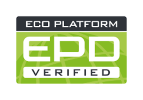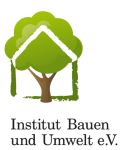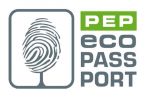A standardized fact sheet for declaration of environmental impacts - Why making and verifiying an EPD?
The overall goal of an Environmental Product Declaration (EPD) according to EN 15804 is to provide relevant, verified and comparable information to meet various customer and market needs. Different EPD systems help and support manufacturers to communicate the environmental performance of their products (goods and services) in a credible and understandable way.
Our mission to support declarations of environmental impacts
- We support such product declarations by investigating the necessary technical data and evaluating the environmental impacts of your products in a life cycle assessment.
- We participate in the development and update of product category rules (PCR) i.e. for electricity and heat.
- You plan to elaborate the EPD on your own? We provide the SimaPro software, training and coaching to help you.
- Furthermore, we verify EPD's according to the international EPD® system and can support you as an approved individual verifier.
EPD platforms for publication of product fact sheets
To register and publish the EPD, the client must register with an operator. So far, we have mainly worked with the international EPD®system and PEP (but are also open to other organizations shown below). The fees are set by this organization and depend, among other things, on the number of EPDs published. The following table shows platform operators for registration and publication of EPDs with which ESU cooperated in the past.
| System | Region | Focus | |
|---|---|---|---|
 | The international EPD®system (environdec) | GLO, English and other languages | All types of products |
 | EPD South-East Asia | Asia | All types of products |
 | IBU-Bau | DE and German speaking, | Building products |
| KBOB, ecobau and IPB | CH, German and English | Building products | |
 | PEP ecopassport (product Environmental Profile) | FR, GLO | Electric and electronic products |
 | Product environmental Footprint (PEF) | EU | Consumer products |
Questions for providing an offer
ESU-services have a great deal of experience in elaborating environmental product declarations. The actual cost for a elaborating an EPD depends on the following factors (please provide more information if not yet available):
- Which products (and how many) should be declared? Can you sent a link or a product description?
- Which PCR should be applied or in which type of product category does the products fall?
- Who is requesting the EPD and have they made any requirements regarding platform or standards to be applied?
- Which platform is foreseen for the EPD publication (e.g. environdec, IBU, KBOB, PEP ecopassport, etc.) and general programme requirements?
- How many EPDs are based on one LCA report?
- Which stages(A-D) and sub-stages of EPD reporting in upstream, core, downstream and reuse sections are modelled?
For questions, you can book the date for a meeting. If you are located in another time zone, you can switch to your time zone (below the calendar). This will should show you correctly slot in your time zone. You should receive an email with a calendar invitation and Teams link after choosing the time and date. Please check your Spam folder if you do not receive such an invitation, or contact us by Email answering the questions above.
Publish other environmental information
Furthermore, ESU elaborated tools and feasibility studies for environmental information
- Our web tools facilitate product declarations for transports and energy products used in Switzerland.
- Within the labelling of renewable energy we elaborate an easy-to-use key parameter tool for calculating an environmental product declaration of electricity, heat, biomethane and cooling labeled with as naturemade star.
- We developed a simple Excel model to calculate the environmental impacts of hydropower plants.
- We investigated the feasibility of providing environmental information for consumer products on behalf of the Federal Office for the Environment (FOEN).
- We also support simplified tools such as the product carbon footprint (PCF) for products and process or the corporate carbon footprint (CCF) for companies and organisations.
- We follow up closely the developments of European Environmental Footprint methods developed by the European Commission
Selected publications of ESU-servics
Meili C., Jungbluth N. 2019 - Lessons learned from assessing life cycle impacts for an environmental product declaration: Examples for run-of-river power plant (conference paper) and presentation at the sustainable built environment conference 2019.